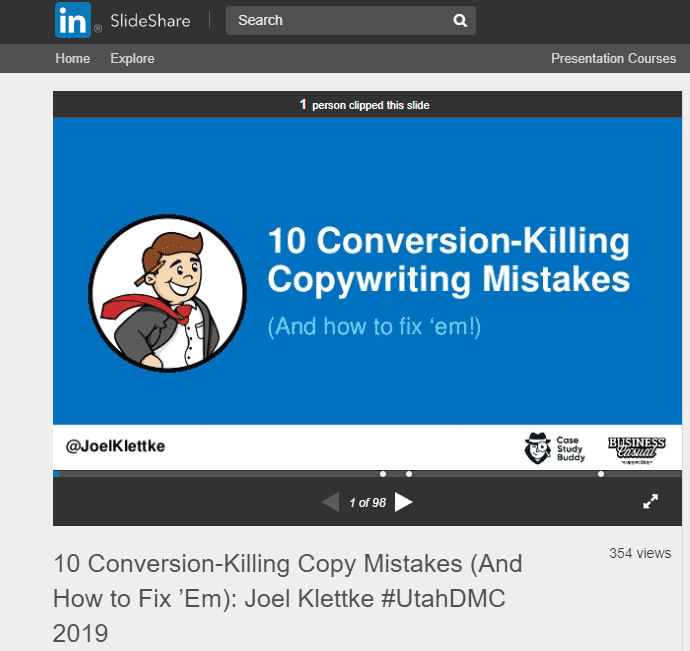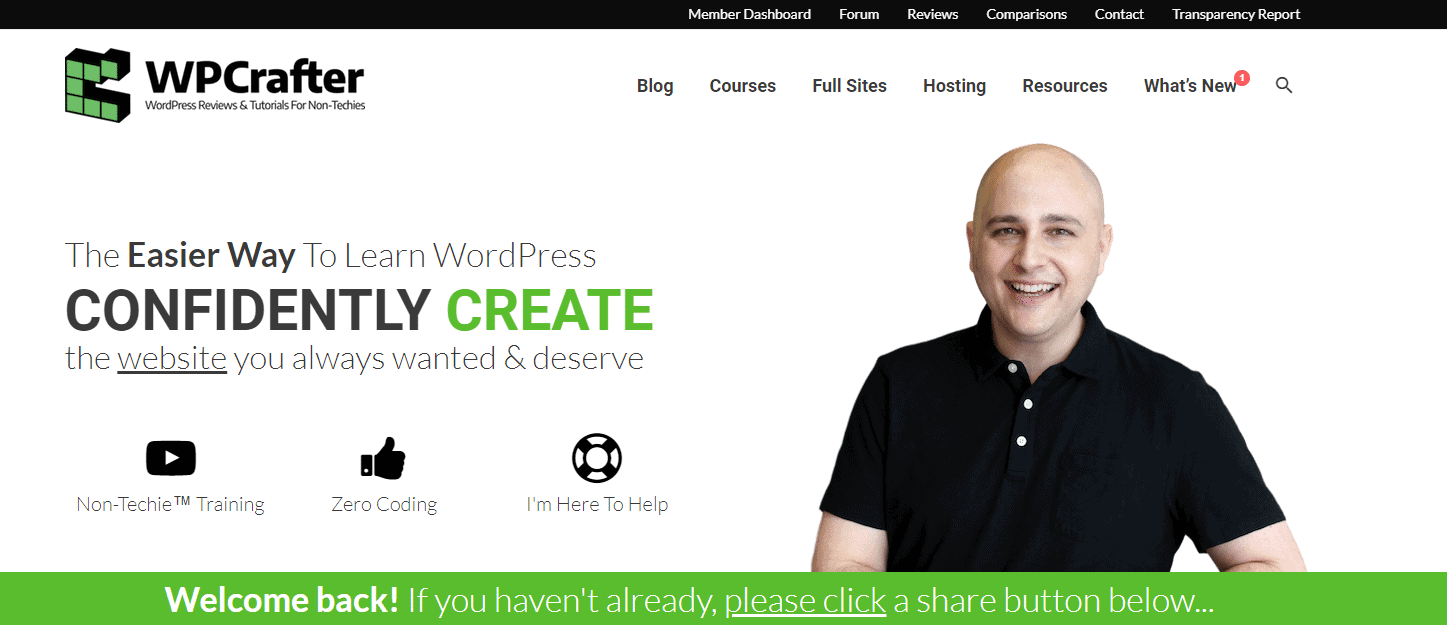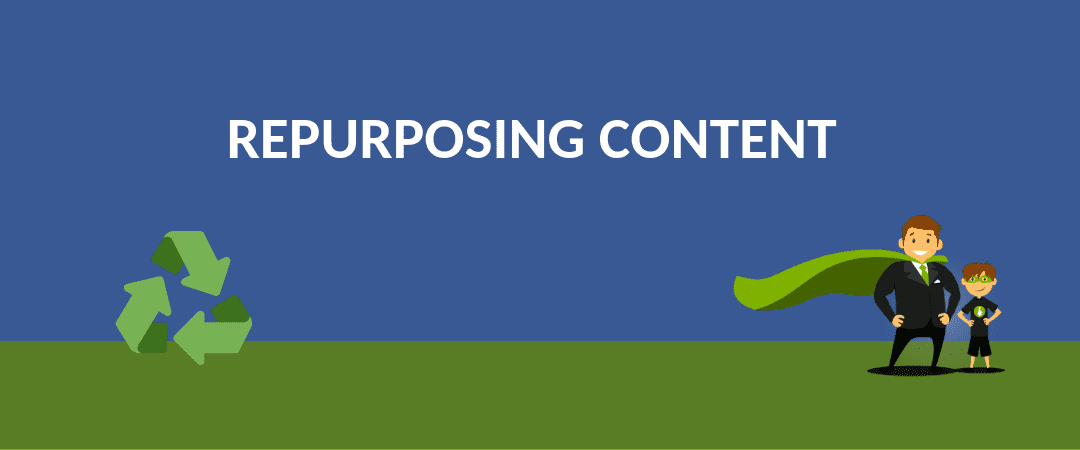Content repurposing allows us to take our best, most evergreen content, and reuse it in a different form for a different platform, and often, for a different audience.
I live in a small town in Arkansas that has a festival that celebrates ecological conservation each Fall. That happens this week. There are all kinds of exhibits. Last year, I took a selfie with an owl [see pic]. In ten years it has become quite a bit of an event. People from all over the state visit to learn more about conservation and recycling.

In years past, they had a cardboard derby race. A large part of the car had to be made from recycled cardboard. I watched some of the races one year. A lot of fun for those kids.
This year, one of the exhibits will be a textile waste area. In this area, among other things, there will be consultants showing how to reuse various types of textile and clothing.
I remember as a kid, when I visited my grandpa up in Northern Arkansas, conservation was a way of life. My grandpa and granny were adept at reusing various things around the house.
Well, content repurposing is similar. It is a tactic that allows us to take our best, most evergreen content, and reuse it in a different form for a different platform, and often, for a different audience.
If Dr. Strange were a content marketer, I know he would use his unusual powers for content repurposing. So, today, we are going to look at three types of content that are ripe for repurposing.
What is content repurposing?
Content repurposing is much like recycling. You simply take some of your best content and reuse it by reforming into a different type of content for a different platform.
As Ben Sailer explains at CoSChedule,
Repurposing content simply means taking one asset and reusing it somewhere else. That sounds simple enough in theory, but it can get tricky in execution. To really make it work, it helps to produce content with repurposing in mind, so you can easily slice and dice it into different formats.
The idea is to make your best content perform double duty by repackaging it and reaching a wider audience. Mary Fernandez says,
Repurposing your blog content is taking a post that you’ve already written and re-packaging it so that it does double duty. This allows you to:
- Reach more potential customers with your content marketing
- Get more organic search engine traffic
- Stop stressing over what to write about
- Devote more time towards making sales
Repurposing content can provide you with many benefits. According to Kevan Lee at Buffer, one benefit is that it saves you a lot of time.
Time is a precious Internet resource, which is why one huge benefit—maybe the hugest—of repurposing content is the time it can save you in the content creation process.
Additionally, as Fernandez notes above, it helps with traffic and you can reach other potential customers. You may also find that you will create better content as you focus more on ways to repurpose. As Sailer says,
The benefits to repurposing content are considerable, too. When you focus your energy on producing one awesome asset (say, an in-depth blog post or video), you’re likely to produce a better piece of work than you would by dividing your attention across every platform you’re responsible for.
The key to repurposing content is to use content that does not go out of date. This is called evergreen content. Focus on building some content that just doesn’t go out of date and then reuse that content.
Content to which you can give a new purpose
Today we are discussing three different types of content that you can give a new purpose. We are going to focus on blog posts, videos, and presentations. So let’s get going.
Blog posts
There are various ways you can repurpose a good blog post. Now, just to be clear, we aren’t talking about blog posts that are really short, contain information that changes often (Google updates) or contains news items. There is a way to take advantage of some of those types of blog posts, but in this example, we are talking about a meaty blog post with information that does not change or rarely changes.
Bullets for Social Media
If your blog post has great value, then most any blog post will do here. If you wrote an article that contains various chunks of extremely valuable sentences, you have the makings of social media pots.
This is great because it allows you to use those bullets (or quotes) to draw attention back to the article.
For example, I am going to take this article from Erin Flynn, 3 Things You Do That Drive Your Clients Nuts. Erin could simply pull out some of the better points in her blog post and queue them into her different social media platforms.
For example, take this nugget in her article:
“When you work on a project that you’re not excited about, you start to resent it, and your client. And they can tell.”
That’s what I did,
"When you work on a project that you’re not excited about, you start to resent it, and your client. And they can tell." @erin3flynn #wordpress #designers #wordpressdesignershttps://t.co/TFSReWVrrz
— Todd E. Jones (@tejones) October 3, 2018
There are several nuggets in that article that would make great quotes for social media. You can also make a social media image using a platform like Canva.
Create a video
Erin did create a video for this article. She posts it in her blog post, and she uploaded the video to Youtube.

Being on Youtube, of course, makes it shareable. Erin also uploaded the video to her Facebook page. She runs a group and has her a business page, and she routinely adds those videos to her library.
A few other things you might do to add new purpose to your content are create a downloadable PDF, turn it into a presentation using Google Presentations or Powerpoint, and use it to send an email newsletter. If the article is very long, you might choose to use the introduction to hook your email subscribers with a link to the blog post.
So, find a new purpose for that stellar blog post you wrote.
Presentations
Presentations usually mean you were invited or accepted to speak to a group of other business owners. This is a real honor. Speaking at a WordCamp, a WordPress Meetup, or a business networking group can give you more credibility and boost your authority.
However, don’t leave all that goodness in the room where you presented. You likely created some kind of presentation in Powerpoint or Google Presentations. If that content is rich and evergreen, then turn it into something that can be shared in various settings.
Copywriter Joel Klettke did just that with a presentation he gave to the 4th Annual Utah Digital Marketing Collective Conference. The presentation is titled 10 Conversion-Killing Copy Mistakes (And How to Fix ’Em) and you can find it on Slideshare.

There are 98 slides and they include all of Joel’s business assets. Now, it resides publicly and anyone can catch the slideshow. They also share enough for any digital business owner to be a little worried he or she might be making the mistakes. Joel to the rescue!
Oh, how that presentation can be repurposed. Joel could use it to host a webinar later or present to a webinar, he can turn it into a short video course, free or paid, where he records him talking through the slides. From that video of him narrating through the slides, he can also use it as a lead magnet. With a little work, he could turn it into an ebook he could give away.
Videos
Finally, if you create a video, you can reuse that in different ways. Following the lead of Erin Flynn, that video can be used on Youtube, Facebook, and even LinkedIn.
The video could be used as a lead magnet or as a bonus for those who have signed up for your newsletter. If you have created enough videos, you can put them together to make a video course. A library of videos can really be helpful.

One person who has leveraged videos this way is Adam Preiser from WPcrafter.com. While Adam has several paid courses, he offers several other how-to videos for non-techie WordPress users on Youtube. He uses the videos in various channels which brings traffic to his site and customers to his courses.
As mentioned in this Social Media Examiner article, you can repurpose your videos by pulling the video and turning it into an audio file or podcast and by ordering a transcription of the video to use in other forms.
Wrapping it Up
Honestly, there are probably as many ways as your imagination can think of to repurpose content. We often see the never-ending drive to create something each week, but our time and resources are limited. Evergreen content for repurposing comes in very handy.
What ways can you think of to repurpose your content? What ways have you repurposed content? Anything unusual? Drop them in the comments below.







